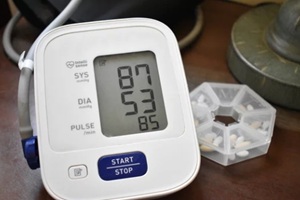 Your blood pressure management is an important vital sign that can significantly affect your overall health. Understanding what constitutes healthy blood pressure ranges and recognizing symptoms of high and low blood pressure empowers you to monitor your health proactively.
Your blood pressure management is an important vital sign that can significantly affect your overall health. Understanding what constitutes healthy blood pressure ranges and recognizing symptoms of high and low blood pressure empowers you to monitor your health proactively.
This article explores common signs and symptoms, risk factors associated with blood pressure abnormalities, and when medical attention may be warranted.
What is Considered Normal Blood Pressure?
Before discussing the signs and symptoms of abnormal blood pressure, it is helpful first to understand what is considered normal. Blood pressure is recorded using two numbers, measured in millimeters of mercury (mmHg).
The first number represents your systolic pressure, which reflects the pressure in your blood vessels when your heart is beating. A normal systolic pressure is less than 120 mmHg.
The second number represents your diastolic pressure, which gauges the pressure level in your blood vessels when your heart pauses between beats. A normal diastolic pressure is under 80 mmHg.
So, for most healthy adults, normal blood pressure is considered to be lower than 120/80 mmHg. However, ideal blood pressure is actually lower. Blood pressure management in this range promotes ideal cardiovascular health.
What Are the Signs and Symptoms of High Blood Pressure?
Recognizing subtle symptoms of high blood pressure or hypertension early is paramount for mitigating associated health risks before complications develop.
Headaches
One of the most common symptoms of high blood pressure is experiencing headaches frequently. In particular, high blood pressure can trigger throbbing pain or tension headaches in the temples upon waking. The mechanism relates to pressure buildup in blood vessels supplying the brain.
Dizziness/Lightheadedness
 Dizzy spells and lightheadedness often manifest when going from a seated or prone position to a standing position. This symptom is due to a sudden blood pressure drop caused by dysfunctional mechanisms for stabilizing blood flow to the brain. Episodes may be brief or lead to momentary loss of balance.
Dizzy spells and lightheadedness often manifest when going from a seated or prone position to a standing position. This symptom is due to a sudden blood pressure drop caused by dysfunctional mechanisms for stabilizing blood flow to the brain. Episodes may be brief or lead to momentary loss of balance.
Vision Changes
Over time, high blood pressure strains the small blood vessels that carry blood to the eyes. This can prompt visual symptoms such as blurred vision, impaired night vision, or seeing spots and floaters. Vision loss may indicate retinopathy related to long-standing hypertension.
Shortness of Breath
Labored or difficult breathing during everyday activities signals that the heart is working overtime to pump blood. Chest pain or tightness may accompany shortness of breath as the coronary arteries endure excessive pressure.
Facial Flushing
A reddened face is another symptom of potential high blood pressure, stemming from blood vessels near the skin’s surface dilating in an attempt to lower pressure. Flushing may also suggest a surge in adrenaline, both a consequence of and contributor to hypertension.
Pounding Sensations
You may perceive alarming pounding, whooshing, or throbbing sensations in your neck, chest, or ears. This experience results from a rapid heartbeat and turbulent blood flow through partially blocked arteries near the skin’s surface.
Nosebleeds
While almost everyone gets a nosebleed now and then, frequent or prolonged bleeding could signify hypertension. The delicate blood vessels inside the nasal passages are especially prone to rupturing when blood pressure spikes.
Severe Symptoms
In a hypertensive crisis with blood pressure exceeding 180/120 mmHg, people may experience anxiety, confusion, severe headache, irregular heartbeat, and stroke symptoms. Without emergency treatment, extremely high blood pressure can damage essential organs.
What Are the Signs and Symptoms of Low Blood Pressure?
 While high blood pressure garners more attention, low blood pressure (hypotension) also warrants awareness. This condition occurs when blood pressure drops under 90 mmHg systolic or 60 mmHg diastolic.
While high blood pressure garners more attention, low blood pressure (hypotension) also warrants awareness. This condition occurs when blood pressure drops under 90 mmHg systolic or 60 mmHg diastolic.
Low blood volume, dilated blood vessels, heart conditions that slow the heartbeat, and certain medications can all trigger low blood pressure. The most common hypotension symptoms include the following:
Lightheadedness Upon Standing
When moving from lying down or sitting to a standing position, blood pools in the legs due to gravity. Less blood reaches the brain, triggering symptoms such as dizziness, weakness, ringing in the ears, or momentary vision loss. These resolve once lying or sitting again.
Blurred Vision
Inadequate perfusion pressure means insufficient oxygen-rich blood flows to the eyes. The eyes require ample blood flow to function properly. Blurry vision results when cells in the retina and optic nerve do not receive steady nutrients and oxygen.
Weakness or Fatigue
With low blood pressure, vital organs and muscles receive insufficient oxygen and nutrients from the bloodstream. This starved blood supply makes people prone to whole-body weakness and excessive fatigue even with minimal activity.
Fainting
As blood pressure drops precipitously low, diminished blood supply to the brain causes rapid loss of consciousness. Fainting serves as the body’s protective mechanism against dangerously inadequate cerebral perfusion.
Cognitive Problems
Mental confusion, attention deficits, slowed thinking, and memory problems may accompany low blood pressure. The brain relies wholly on constant oxygen-rich blood flow, which dwindles with hypotension. For seniors, this raises the risk of dementia progression.
Nausea
The digestive tract requires robust blood flow for proper functioning. When blood pressure decreases, the stomach and intestines endure depleted perfusion. The result can be pronounced nausea, vomiting, cramping, or loss of appetite.
Rapid, Shallow Breathing
The body instinctively breathes faster and shallower to compensate for low blood pressure and perturbed gas exchange. This transiently helps increase oxygen saturation but proves an imperfect, inefficient mechanism.
Clammy, Pale Skin
The body constricts peripheral blood vessels and minimizes circulation to the skin when blood pressure drops. The goal is to redirect the limited blood supply to vital organs to avert organ damage, causing cold, sweaty, unusually pale skin lacking its normal rosiness.
 If low blood pressure produces recurrent, troubling symptoms or you lose consciousness, a full medical workup is warranted to uncover any underlying conditions provoking blood pressure drops.
If low blood pressure produces recurrent, troubling symptoms or you lose consciousness, a full medical workup is warranted to uncover any underlying conditions provoking blood pressure drops.
Partner with Imperial Center Family Medicine for Blood Pressure Management
Imperial Center Family Medicine’s skilled and compassionate healthcare providers have extensive training in evidence-based approaches for maintaining healthy blood pressure.
If you are looking for blood pressure management techniques through natural means or require medication, our expertise provides solutions personalized to your health status and wellness goals. Contact us today at 919-873-4437 or online to schedule your initial hypertension consultation.
